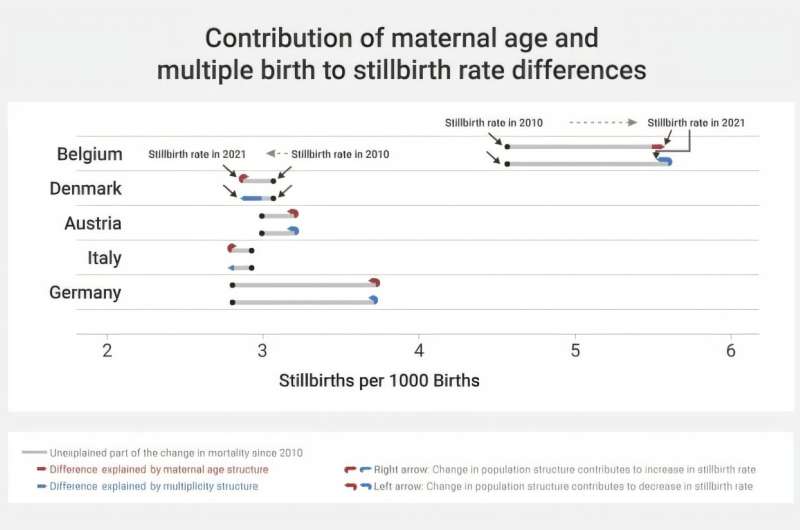The stillbirth rate in Europe has been steadily improving over the last few decades, but there are some exceptions. In Germany and Belgium, rates have significantly increased since 2010, while other European countries have seen declines or stability.
Researchers from the Max Planck Institute for Demographic Research (MPIDR) have investigated how factors like increasing maternal age and multiple births may have influenced these trends and differences across Europe. The analyses, published in the European Journal of Public Health, indicate that these factors explain only a small portion of the variations.
Similar to life expectancy, the stillbirth rate has improved continuously in recent decades. However, this progress is not uniform across Europe. Most countries have seen rates drop to below three stillbirths per 1,000 live births, while in some countries the rate is stagnating or rising. There are also significant differences between countries.
The recent study by researchers from the Max Planck Institute for Demographic Research (MPIDR) in Rostock, Germany, along with researchers from the University Medical Center Rotterdam, the University of Iceland and the National University Hospital of Iceland, examined the reasons behind these trends.
“We first looked at how stillbirth rates in Europe changed between 2010 and 2021, focusing on whether the recent increase in stillbirth rates in Germany is unique,” explains Maxi Kniffka, researcher at MPIDR. The study also looked at how rising maternal age and changes in multiple births might explain the differing trends across countries. Both factors are among the most popular explanations for changes in fertility rates.
For the study, the researchers used data from the Euro-Peristat network, established in 1999 as part of the EU Health Monitoring Program. “We looked at annual stillbirth rates by maternal age and multiple births. This data set was adjusted across countries to a largely uniform definition of stillbirth, so that distortions in comparisons between countries could be reduced,” says Kniffka.

Trends in Germany and Belgium
The analyses show that stillbirth rates in most European countries are still declining or stable at a low level. Germany and Belgium stand out with a clear and significant upward trend in stillbirths since at least 2010. In Germany, the number of stillbirths per 1,000 births rose from 2.8 in 2010 to 3.7 in 2021. Belgium saw an increase from 4.6 to 5.6 over the same period. In contrast, in Spain and Denmark, the rate fell from 3.1 to 2.7 and from 3.1 to 2.9 , respectively, while in countries such as Austria and Italy it stagnated.
The study concluded that the increasing maternal age and changes in the proportion of multiple births only partially explains the rising stillbirth rates. The age of mothers at birth has generally increased. As advanced maternal age is connected to a higher risk of stillbirth, this increase contributes to an increase or dampens the decrease in national stillbirth rates.
At the same time, the proportion of multiple births has decreased in most countries. “As these pregnancies are associated with a higher risk of stillbirth, this decline has contributed to a reduction in stillbirth rates in most countries,” explains Kniffka. In Germany, the slight decline in multiple births has not been enough to counteract the rising stillbirth rate.
Maternal age and the number of multiple births offer only a limited explanation for the differences in rates between countries, as countries tend to converge on these demographic factors and the overall risk of stillbirth at advanced maternal age in the countries studied decreased between 2010 and 2021.
Germany, for example, had a higher stillbirth rate in 2021 than the average of all the countries studied. Consequently, differences in the age of the mothers or the prevalence of multiple pregnancies play only a minor role in this.
More research needed into the causes of the increase
The researchers acknowledge that they do not yet fully understand the reasons behind the changing stillbirth rate in most European countries, and particularly in Germany. However, at least for Belgium, it could also be due to a change in the number of late abortions, as these could not be excluded from the stillbirth figures in Belgium.
There are a number of possible causes that could lead to an increase in the stillbirth rate. Due to the limited availability of data, only two determinants were initially examined, but future studies will investigate further.
Stillbirth rates are an indicator of the quality of a country’s health system, and “If stillbirth rates are no longer falling, or are even rising, as in Germany, deeper exploration into the underlying causes is warranted,” says Maxi Kniffka.
More information:
Maxi S Kniffka et al, Stillbirth rate trends across 25 European countries between 2010 and 2021: the contribution of maternal age and multiplicity, European Journal of Public Health (2025). DOI: 10.1093/eurpub/ckae214
Citation:
Understanding the increase in stillbirth rates in Germany amid European declines (2025, February 3)
retrieved 3 February 2025
from https://medicalxpress.com/news/2025-02-stillbirth-germany-european-declines.html
This document is subject to copyright. Apart from any fair dealing for the purpose of private study or research, no
part may be reproduced without the written permission. The content is provided for information purposes only.

